This episode of “The Big Picture” depicts the Green Berets and features the legendary Larry Thorne (Lauri Törni).
Colored using DeOldify algorithm.
National Archives and Records Administration
This episode of “The Big Picture” depicts the Green Berets and features the legendary Larry Thorne (Lauri Törni).
Colored using DeOldify algorithm.
National Archives and Records Administration
TAMPA, Fla. — Of the 3,536 Medals of Honor presented since its establishment in 1861, only 61 recipients are alive today, and only a handful of them come from the U.S. special operations forces community.
Yesterday, three of those SOF recipients attended a panel discussion at Special Operations Forces Week 2025 in Tampa, Florida.

Retired Army Sgt. Maj. Thomas P. Payne, retired Army Master Sgt. Earl D. Plumlee and Army Command Sgt. Maj. Matthew O. Williams shared experiences and lessons learned from their heroic actions during an hourlong conversation that emphasized the importance of trust, mentorship and resilience in leadership.
All three men explained what being a Medal of Honor recipient means to them on a personal level.
“Every time we put the medal on, it’s a gracious gift to sit here and talk about it,” said Williams, who received the medal for his actions of valor during Operation Commando Wrath in Afghanistan in 2008.
He added that a surprising number of people are unaware of the medal’s significance.
“And that significance has nothing to do with the guy wearing it, or the action that they took; but it’s the idea that you’re willing to put yourself and your life on the line for the guys [to the] left and [to the] right of you,” he said.
Plumlee, who received his medal for saving numerous lives by mounting a successful counterattack under heavy fire against Taliban insurgents in Afghanistan in 2013, explained that he shared his ceremony with two other recipients, both of whom received the medal posthumously.
“That really brought some gravity,” he said.
He also explained that, with credible eyewitness testimony being a requirement for receiving the medal, many SOF personnel may be just as deserving of such an award but will never receive the recognition.
“I know a lot of guys who have done very heroic things, but it’s not captured and provable, [so] there’s no medal for it,” Plumlee said.
“It’s humbling, and I like to say that I’m wearing [the medal] for [the U.S. Special Operations Command] and vast amounts of operators who have done very heroic things for very little recognition, and [who] just went back to work the next day,” he added.
“Just letting the medal be a part of my life [has] required me to grow up,” said Payne, who received his MOH for saving 70 hostages with little regard for his own life during a 2015 rescue operation in Iraq.
“It’s just a process to live up to the standard of wearing the Medal of Honor, which is hard — every single day — and so, it’s a ‘beautiful burden,'” Payne added, quoting his friend and fellow recipient, retired Marine Cpl. Kyle Carpenter.
The three men also spoke about their shared passion for continued service following their time in uniform.
Plumlee said he gets the most out of inspiring others to serve their country.
“I love talking to people [who] were not thinking about serving — or if they’re dabbling in it — and really, you know, mentoring [them] and lighting that fire,” Plumlee said, adding that the country is always in need of men and women to sign up for military service and “take ownership of the country.”
“Every politician’s speech and every successful business is built on the bedrock of the security that the [Defense Department] provides,” he said.
Williams also said he enjoys encouraging others to serve, if not in the military, then in some other manner that benefits the country.
“One thing that really shocked me when I received the medal … was how much I enjoyed talking to other people about it and just perpetuating the values that we stand for … especially service, and how important service actually is,” Williams said.
“I like just talking about that — engaging specifically with kids and students — and going to schools and hoping to provide a little bit of a glimmer of hope for our country,” he added.
Payne said SOF operators like himself and the others on stage have lots of friends buried at Arlington National Cemetery in Virginia, and that he and his fellow SOF veterans are fortunate to be alive.
“I’ve just tried to live an extraordinary life in honor of my teammates … We’re on ‘plus time’ now,” he said, adding that, despite having been medically retired from the Army, he continues to find ways to serve his country.
“There’s a passion to serve still [and] I’m going to continue to serve in different ways,” Payne said.
By Matthew Olay, DOD News
America woke up on the morning of 25 April, 1980 to hear President Carter announced to a stunned world that overnight our nation had undertaken an ambitious raid into Iran to liberate 52 American hostages held illegally at our Embassy compound in Tehran. The assault force of what was known as “Operation Eagle Claw” can be seen here, loading C141s on their way to an Intermediate Staging Base in preparation for the operation.
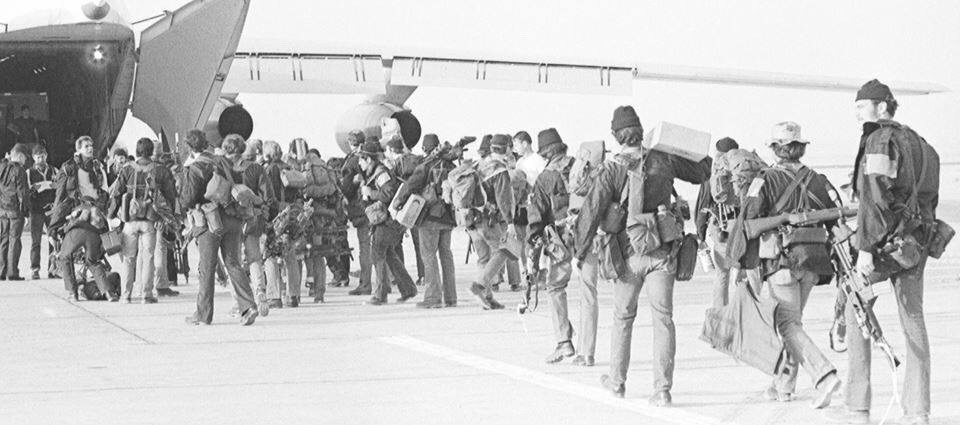
Unfortunately, the plan was complicated and the task force was made was made up of forces which hadn’t trained together long. The weather was problematic as well, and as the task force began to organize a withdrawal from Iranian territory after one-too-many helicopter failures, disaster struck.
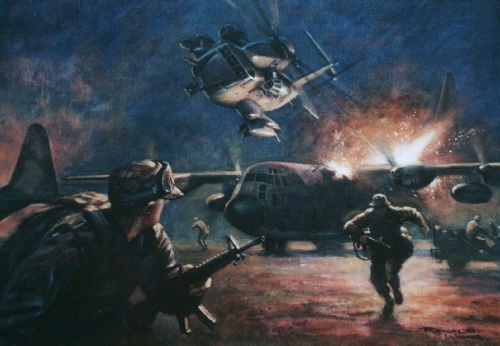
We lost eight American servicemen in a horrible aircraft ground collision during refueling operations where a hovering SH53 helicopter turned into a C130 full of fuel bladders.
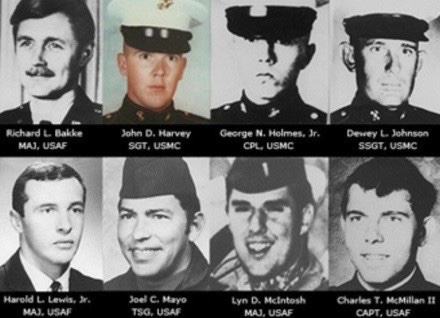
However, their deaths were not in vain. The hostages were eventually repatriated and the accident was the watershed event that created, over the next several decades, the world’s preeminent Special Operations capability; USSOCOM and its components. Forty-five years later, we wouldn’t be where we are without the determination of that fledgling task force.
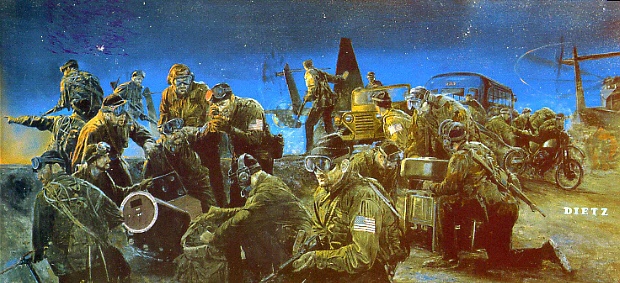
Join me in remembering those who had the guts to try; legends to a man.
In an honorable and dignified ceremony marked by historical significance, former President John F. Kennedy was officially inducted as a Distinguished Member of the Special Forces Regiment in Pinehurst, North Carolina, April 11.
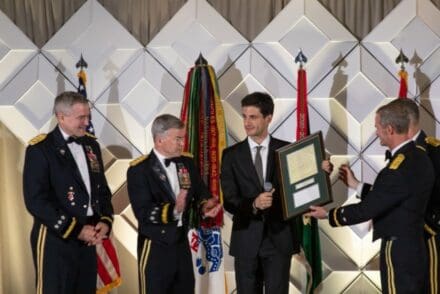
The U.S. Army Regimental Honors program recognizes individuals who have significantly contributed to the welfare, strength, and legacy of a regiment. The ceremony honored Kennedy posthumously, recognizing his visionary support for Special Forces and his enduring influence on modern warfare.
Jack B. Kennedy Schlossberg, Kennedy’s grandson, accepted the official acknowledgement of Kennedy’s induction into the regiment from Maj. Gen. Jason C. Slider, commanding general of the U.S. Army John F. Kennedy Special Warfare Center and School, the Special Operations Center of Excellence (SOCoE).
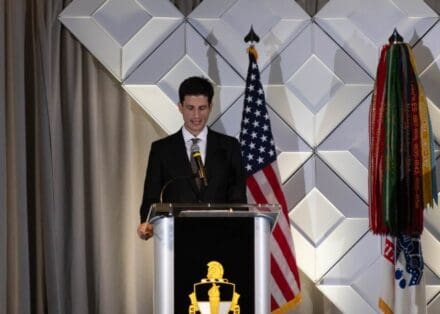
“Today, I’ll never forget it,” Schlossberg said, who accepted the distinction on his family’s behalf. “I can’t think of a better way to honor President Kennedy by teaching new generation to live by the values that he did and to hold them to the same high standard that history holds them to. The Special Warfare School is a living tribute to all that my grandfather stood for.”
In addition to Kennedy’s contribution to Special Forces history stood the former schoolhouse commander at the time, Lt. Gen. William P. Yarborough, whose determination parallelled the vision in establishing what would become the next generation of lethal warfighters, the Special Forces Soldier.
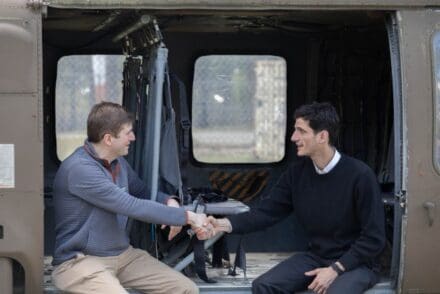
“Yarborough was a warfighter,” Slider said. “He fought and commanded in World War II with the 82nd Airborne Division. He was a leader of men, and he cared for them. He created the silver wings many of us are wearing tonight. He also designed the paratrooper jump boots. He was an infantryman, but his legacy is “the father of the modern Green Berets.”
Michael Yarborough, Lt. Gen. Yarborough’s grandson, attended the ceremony on his family’s behalf.
“This letter marked the milestone in the transformation to the Army as it responded to a wide variety of new and emerging threats that included unconventional warfare in faraway places like Vietnam,” said Yarborough, during his remarks at the induction ceremony. “Six months before he penned that letter, Kennedy visited Fort Bragg and my grandfather at the Special Warfare School […] I’m confident that President Kennedy, if he visited Bragg today, would look to Special Forces to bring any capabilities and moral character the Army needs as it continues to defend our country.”
The significance of the ceremony reflected a milestone in Special Forces history, the 63rd anniversary of Kennedy signing the memo that authorized the wearing of the Green Beret on April 11, 1962.
Because of Kennedy and Yarborough’s deep-rooted legacy in paving the path for Army special operations forces, the U.S. Army John F. Kennedy Special Warfare Center and School stands as a living legacy of their contributions and a pillar of excellence in the world of special operations military training and force generation.
Kennedy’s military history traces back during his time as a lieutenant in the U.S. Navy during World War II. Kennedy’s actions spoke to his character when he commanded a PT boat in the Pacific. In 1943, his boat, PT-109, was rammed and sunk by a Japanese destroyer. Despite his own injuries, Kennedy led his crew to safety. After World War II, Kennedy would go on to be elected as a democratic congressman for Massachusetts, serving three terms, and eventually becoming the 35th President of the United States of America in 1960.
During his presidency, in October 1961, after watching a demonstration of Special Forces capabilities at McKellar’s Lodge, Kennedy approved the Green Beret as the official headgear of Army Special Forces during his visit to Fort Bragg.
Following his visit on April 11, 1962, Kennedy penned an official White House Memorandum stating, “The Green Beret is again becoming a symbol of excellence, a badge of courage, a mark of distinction in the fight for freedom.”
Shortly after Kennedy’s assassination, as a tribute to his support, Yarborough added Kennedy’s name to the U.S. Army Center for Special Warfare, the previous name of the SOCoE. Named in his honor, the institution reflects Kennedy’s unwavering belief and executive sponsorship of unconventional warfare. His contribution to the fabric of Special Forces history was filled with many accomplishments and honorable service in the military, leading to his induction into the regiment.
While the induction falls on the anniversary of the signing of the memo, the induction references an action taken when Kennedy was first interred into Arlington.
At that time, moments after the assassinated president’s casket descended into the ground, boughs of pines were laid on the mound, and his 47-man Special Forces contingent that supported his internment was leaving, former Command Sgt. Maj. Francis Ruddy, the U.S. Army Center for Special Warfare command sergeant major, overcome by emotion, laid his beret down on the grave site.
“It was pretty much a reflex,” Ruddy said 14 months later with a New York Times reporter. “I stood there with a feeling of complete helplessness. I felt we lost a truly great person.”
When Robert F. Kennedy and Jackie returned to Arlington at midnight, they found Ruddy’s beret among the pine boughs that laid on top of the piled dirt. Ruddy explained to the Associated Press days after the funeral that “we considered it appropriate that it be given back to him.”
“President Kennedy’s confidence in our formation, his investment in our force, and his understanding of unconventional warfare leads us to stand as ready to respond to our nation today as we did 60 years ag,” said Lt. Gen. Jonathan P. Braga, commanding general of the U.S. Army Special Operations Command, during the induction ceremony. “As past Green Berets were able to stand guard over President Kennedy and honor his leadership in his family’s time of need; today, we Green Berets codify his legacy as one strongly intertwined with our own.”
During the ceremony, Schlossberg presented Gen. Bryan P. Fenton, commanding general of the U.S. Special Operations Command, with a page of Kennedy’s famous West Point speech in 1962 that included President Kennedy’s notes and edits from over six decades ago.
“On behalf of all of us, we formally welcome you to the Special Forces family,” Fenton said, during closing remarks.
Kennedy remains the only American president officially inducted into the Special Forces Regimental Hall of Fame as a Distinguished Member of the Regiment. His image, depicted in Special Forces halls and classrooms, continues to inspire generations of warriors. The ceremony not only honored his past contributions but also reaffirmed that his ideals remain firmly embedded in the heart of special operations.
To read President John F. Kennedy’s biography from the ceremony, visit www.swcs.mil/Portals/111/DMOR_2025_SF_JFK
By Elvia Kelly, U.S. Army John F. Kennedy Special Warfare Center and School
The Bunker has created two nostalgic retro nin subdued cloth badges of the Combat Action Badge and the Air Assault Badge! Now, you can make up your uniform as it would have looked pre 1968 but with badges that didn’t exist back then. The last pic shows them mixed in with original non subdued badges as the Army wore them on fatigue uniforms pre-1968.
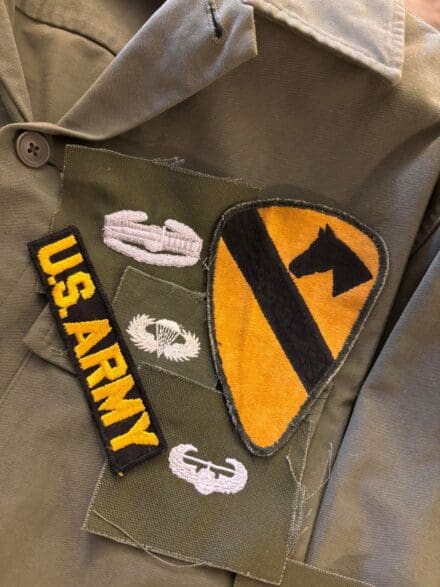
They made a limited tun of thes two badges so stop by The Bunker and get yours before they’re gone. If sales are good and they receive enough requests for other badges they’ll have them made as well.
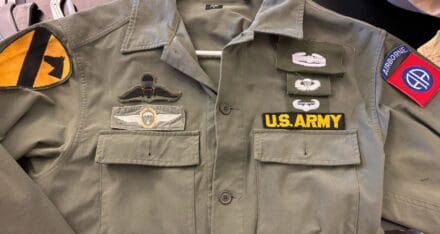
What’s that? Why didn’t they do other badges? Well, first of all this is a test to see if there is any interest in this market idea. Second, they figured they would make those that are: a) widely earned and have a great audience for sales and b) badges that the owner can use on his own retro fashion wear so he could make up a shirt and wear it about.
The owner added a note: yeah, I know the Army reg stated you could only wear one foreign badge above the right pocket. However, I’m already wearing two badges that didn’t exist back then so why hold back!! Now, he just needs to find Greek and Irish non-subdued cloth jump wings!
linktr.ee/The_bunker_in_aberdeen
250 years ago today, the American Revolution kicked off with the “shot heard around the world.” By the time the continental Congress had gotten its act together on July 4th, 1776, declaring independence, we had already been at war with England for well over a year. The army had not even been formed yet on the morning of April 19, a day we now call “Patriot’s Day.” Instead, we relied upon a militia, made up of hard, armed men who knew right from wrong and stood for the guiding American principle of liberty. They took a stand against oppression, vowing to accept it no more.
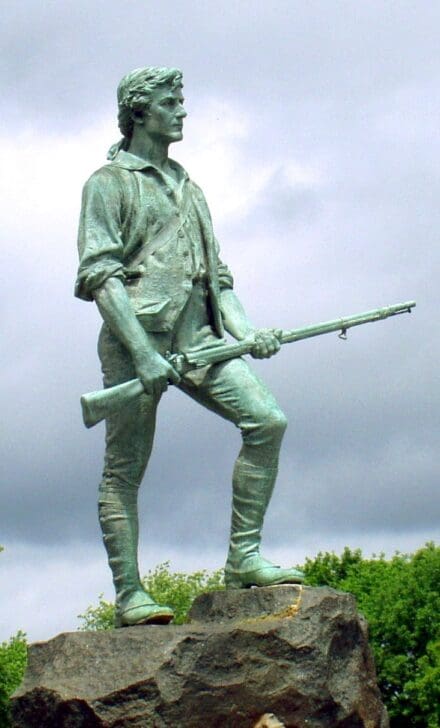
The town’s Minute Men where called to arms in the early morning of April 19, 1775 after being alerted by riders from Boston that British troops were on the march to seize arms and powder stored at a local magazine. The colonists were determined to protect their means of protection from tyranny. If you’ve ever wondered why the Second Amendment to the Constitution exists, this is the watershed moment.
The militia was under the command of Captain John Parker, who rallied them with these immortal words:
“Stand your ground. Don’t fire unless fired upon, but if they mean to have a war, let it begin here.”
Shots did ring out, although to this day no one knows who fired first. The subsequent Battle of Lexington and Concord marks the beginning of a path to a new nation, now known as the United States of America.
As the initial volleys of fire were exchanged near daybreak on Lexington Green, colonial volunteers fell back in the face of over 500 occupying British troops. But as the battle moved on to Concord, the tide turned, and the redcoats were routed as more and more colonists joined the fray.
The British troops retreated through Concord where they were reinforced. Despite eventually boasting a strength of 1700 men, they remained no match for the determined colonists who forced them to retreat to the safety of Charlestown in Boston. The militiamen grew in number along the way to a force of almost 4000 string, pursuing the British in an action which transformed into the Siege of Boston.
We won that battle and others, losing quite a few along the way, but with the signing of the Treaty of Paris on 3 September, 1783, we Americans would eventually be triumphant in a war that involved many of the world’s major powers and spanned the globe, to earn our full independence.
God bless those men and God bless this nation.
– Eric Graves
Founder
Soldier Systems Daily
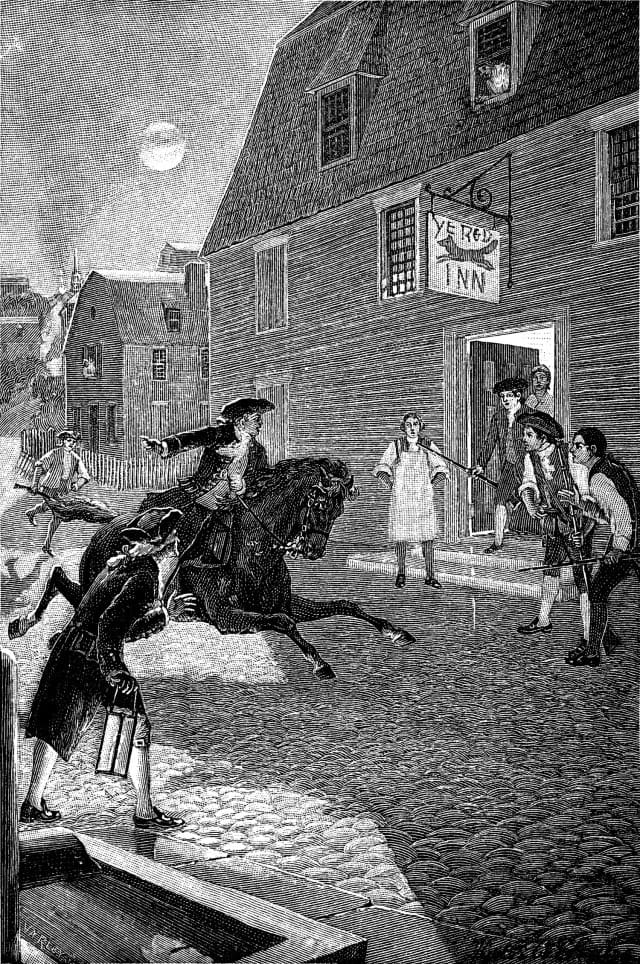
WASHINGTON — As the nation commemorates the 250th anniversary of the beginning of the Revolutionary War in April, the Army looks back at the roots of its legacy of service.
Paul Revere and his midnight ride is one of the most recognized images from the events surrounding the battles at Lexington and Concord on April 19, 1775. While most people think of him as a lone actor, he was part of a much larger network of early warning intelligence systems and communication nodes the Army later developed into the Signal Corps and military intelligence.
The crisis that led Paul Revere on his famous midnight ride didn’t begin overnight.
Resistance Groups
When Britain began to place more financial burdens on the colonists in the 1760s and remove fundamental rights, many colonists began to organize resistance groups like the Sons of Liberty.
By 1774, Massachusetts was the focal point for civil unrest, and the British government took extreme measures against the colony. The Crown curtailed most civil liberties, closed the port of Boston, and in October, dissolved the colonial legislature.
In response, the legislature continued to meet as the representatives of the people, calling itself the Massachusetts Provincial Congress. Working through the Fall, the Provincial Congress established a Committee of Safety, reorganized the colony’s militia, encouraged more efficient leadership, and established higher standards of readiness for quick-reaction units, known as minute battalions. Soldiers in these units tended to be younger, more highly motivated, better trained, and were known as “minutemen.”
Most minute units were led by combat veterans of the French and Indian War (1754-1763). By early 1775, nearly 20,000 troops were organized in militia regiments and minute battalions across the colony.
Secret caches
To support the combat element of what was being referred to as the Massachusetts Provincial Army, the Congress established a Committee of Supplies to amass military stores and equipment in secret caches around the colony.
Communities hid small arms, ammunition, artillery pieces, tents, entrenching tools, medical chests, and other supplies in gardens, outbuildings, and basements. If the growing force of 4,000 British regulars in Boston were ever to begin a conflict in Massachusetts, the Provincial Army would need these supplies to rapidly mass and meet them in combat.
Since the citizen-soldiers of the militia could not stay on alert permanently, the provincials organized a robust intelligence and signal network to provide early warning if a threat appeared.
Intelligence agents inside Boston collected information on British plans and speedily sent word into the countryside so that the Provincial Army were almost as informed of the actions of the British military as the British were themselves.
The Committee of Safety established a network of alarm riders in the counties around Boston to be able to rapidly spread the word should the Sons of Liberty have actionable intelligence.

Paul Revere
An early member of the Sons of Liberty who had experience carrying urgent messages across the colonies was 40-year-old silversmith Paul Revere.
By April of 1775, he was one of those in Boston entrusted with the mission of passing through British lines to carry word into the countryside should the regulars ever march on a provincial target. If caught with incriminating information, Revere and the other alarm rides could suffer imprisonment or death.
On the evening of April 18, patriot leader Joseph Warren received intelligence that a force of about 700 redcoats was assembling to march west toward Concord the next day to seize military supplies and arrest members of the Provincial Congress.
Warren instructed Paul Revere and William Dawes to escape the city and activate the colony’s alarm network.
Unsure if the British force would march out via Boston neck or ferry their troops across the Charles River toward Cambridge, Revere coordinated signal lanterns in the steeple of Boston’s Old North Church: one if by the land route, two if by water.
This simple but effective code let Revere and other alarm riders know just before midnight that Royal Navy sailors were ferrying the regulars to Lechmere Point.
Revere slipped past the warships in Boston harbor to Charlestown, where he mounted his horse and raced westwards to spread the alarm.
Joined by William Dawes, who had spread the alert on the route from Boston Neck, Revere rode through the night toward Concord, spreading word that, “The regulars are coming out!” This triggered the colony’s alarm network.
Alert riders spread the word north, west, and south, with word reaching as far away as New Hampshire, Maine, and Rhode Island by the end of the day on April 19.
The network activated some 14,000 militia and minutemen in 47 regiments all within marching distance of Concord.
Church bells and drums called the soldiers to muster, families cooked rations and rolled cartridges, and dozens of companies began their march.
Few thought it would be the first action in what would become an eight-year war for independence, nor that someday an organization called the U.S. Army would develop signal network systems based on relays to communicate across the battlefield. The groundwork established in colonial Massachusetts forms the basis for the modern-day Army Signal Corps and military intelligence branches.
By MAJ Jonathan Bratten, U.S. Army Center of Military History
Live on Kickstarter now, “Soviet Weapons of the Atomic Age” is an upcoming photo book depicting history of the Soviet Weapons of the early post-WW2 period.

Written by Vlad Besedovskyy, who also authored “Soviet Weapons of the Afghan War” and published by Safar Publishing, this volume will boast 400 pages covering Pistols, Sniper Rifles, Automatic Rifles, Machine Guns and Grenade Launchers.
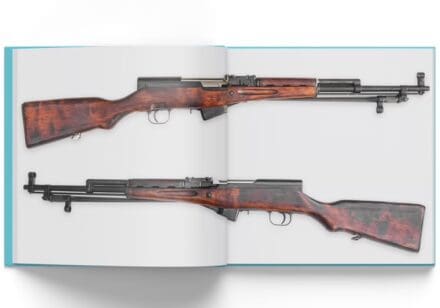
They will offer historical context for each featured weapon, exploring their design, development, and deployment including exclusive content from private collections and archives.
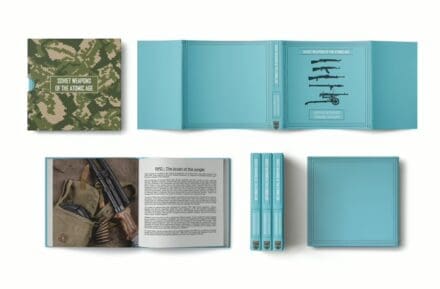
Back the project here.